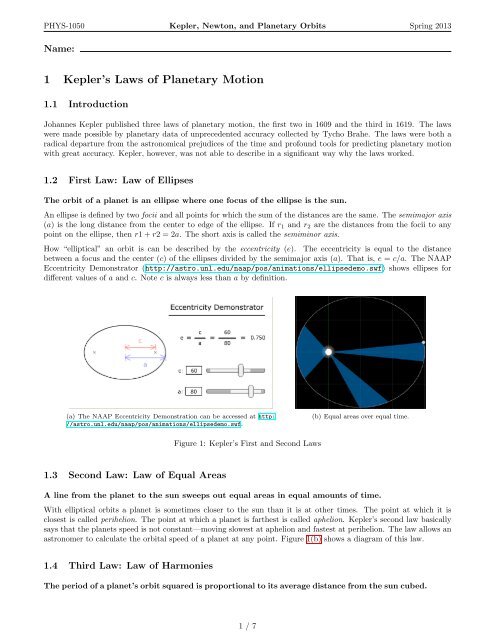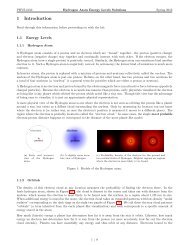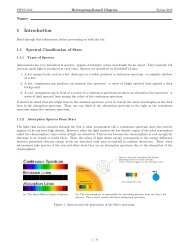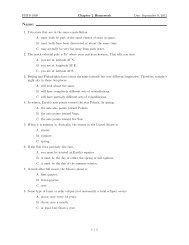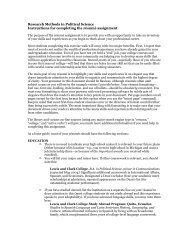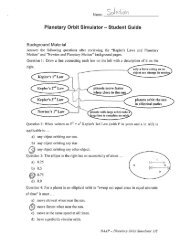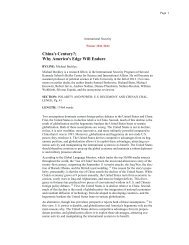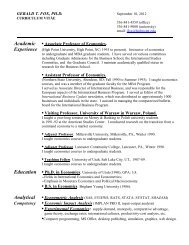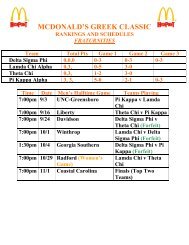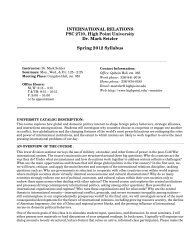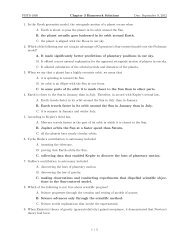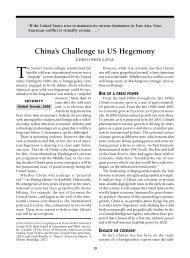Kepler, Newton, and Planetary Orbits - High Point University
Kepler, Newton, and Planetary Orbits - High Point University
Kepler, Newton, and Planetary Orbits - High Point University
Create successful ePaper yourself
Turn your PDF publications into a flip-book with our unique Google optimized e-Paper software.
PHYS-1050 <strong>Kepler</strong>, <strong>Newton</strong>, <strong>and</strong> <strong>Planetary</strong> <strong>Orbits</strong> Spring 2013<br />
Name:<br />
1 <strong>Kepler</strong>’s Laws of <strong>Planetary</strong> Motion<br />
1.1 Introduction<br />
Johannes <strong>Kepler</strong> published three laws of planetary motion, the first two in 1609 <strong>and</strong> the third in 1619. The laws<br />
were made possible by planetary data of unprecedented accuracy collected by Tycho Brahe. The laws were both a<br />
radical departure from the astronomical prejudices of the time <strong>and</strong> profound tools for predicting planetary motion<br />
with great accuracy. <strong>Kepler</strong>, however, was not able to describe in a significant way why the laws worked.<br />
1.2 First Law: Law of Ellipses<br />
The orbit of a planet is an ellipse where one focus of the ellipse is the sun.<br />
An ellipse is defined by two focii <strong>and</strong> all points for which the sum of the distances are the same. The semimajor axis<br />
(a) is the long distance from the center to edge of the ellipse. If r1 <strong>and</strong> r2 are the distances from the focii to any<br />
point on the ellipse, then r1 + r2 = 2a. The short axis is called the semiminor axis.<br />
How “elliptical” an orbit is can be described by the eccentricity (e). The eccentricity is equal to the distance<br />
between a focus <strong>and</strong> the center (c) of the ellipses divided by the semimajor axis (a). That is, e = c/a. The NAAP<br />
Eccentricity Demonstrator (http://astro.unl.edu/naap/pos/animations/ellipsedemo.swf) shows ellipses for<br />
different values of a <strong>and</strong> c. Note c is always less than a by definition.<br />
(a) The NAAP Eccentricity Demonstration can be accessed at http:<br />
//astro.unl.edu/naap/pos/animations/ellipsedemo.swf.<br />
1.3 Second Law: Law of Equal Areas<br />
Figure 1: <strong>Kepler</strong>’s First <strong>and</strong> Second Laws<br />
(b) Equal areas over equal time.<br />
A line from the planet to the sun sweeps out equal areas in equal amounts of time.<br />
With elliptical orbits a planet is sometimes closer to the sun than it is at other times. The point at which it is<br />
closest is called perihelion. The point at which a planet is farthest is called aphelion. <strong>Kepler</strong>’s second law basically<br />
says that the planets speed is not constant—moving slowest at aphelion <strong>and</strong> fastest at perihelion. The law allows an<br />
astronomer to calculate the orbital speed of a planet at any point. Figure 1(b) shows a diagram of this law.<br />
1.4 Third Law: Law of Harmonies<br />
The period of a planet’s orbit squared is proportional to its average distance from the sun cubed.<br />
1 / 7
PHYS-1050 <strong>Kepler</strong>, <strong>Newton</strong>, <strong>and</strong> <strong>Planetary</strong> <strong>Orbits</strong> Spring 2013<br />
The average distance of a planet from the sun is equal to its semimajor axis (a). If the period (P ) is measured in<br />
years <strong>and</strong> the semimajor axis (a) is given in astronomical units (the earth sun distance is 1 AU) then <strong>Kepler</strong>’s Third<br />
Law can be written:<br />
P 2 = a 3<br />
However, this equation is only good for our solar system. Isaac <strong>Newton</strong> was able to derive a more general form of<br />
the equation using his Law of Gravitation.<br />
2 <strong>Newton</strong> <strong>and</strong> <strong>Planetary</strong> Motion<br />
2.1 Introduction<br />
In 1687 Isaac <strong>Newton</strong> published Philosophiae Naturalis Principia Mathematica, a work of immense <strong>and</strong><br />
profound impact. <strong>Newton</strong>’s pronounced three laws of motion <strong>and</strong> a law of universal gravitation. They were a united<br />
set of principles which applied not only to the heavens but also to the earth in a uniform way. Their simplicity <strong>and</strong><br />
extremely broad applicability forever changed astronomy.<br />
2.2 First Law of Motion: Law of Inertia<br />
A body remains at rest, or moves in a straight line (at a constant velocity), unless acted upon by a<br />
net outside force.<br />
The law of inertia did not originate with <strong>Newton</strong>, nevertheless it is integral to his system of mechanics. An object<br />
in motion will remain in motion unless something acts upon it. Because a planet is moving in an ellipse (i.e. not<br />
a straight line) this law states that there must be some “force” acting upon the planet. If there were no force, the<br />
planet would fly off in a straight line.<br />
Figure 2: When the string is released, the ball will fly straight away, not along the curve.<br />
2.3 Second Law of Motion: F = ma<br />
The acceleration of an object is proportional to the force acting upon it.<br />
The first law says that if no force is acting on an object, it will remain in motion. The second law tells how the<br />
motion will change when a force acts upon the object. Velocity is how fast an object is moving (speed or magnitude)<br />
<strong>and</strong> the direction it is moving. Acceleration is a change in velocity. An accelerating object can either change how<br />
fast it is moving, the direction it is moving, or both.<br />
2.4 Third Law: Law of Reciprocal Actions<br />
For every action, there is an equal <strong>and</strong> opposite reaction.<br />
2 / 7
PHYS-1050 <strong>Kepler</strong>, <strong>Newton</strong>, <strong>and</strong> <strong>Planetary</strong> <strong>Orbits</strong> Spring 2013<br />
The law can be more fully stated as, “Whenever one body exerts force upon a second body, the second body exerts<br />
an equal <strong>and</strong> opposite force upon the first body.” That is, when the sun pulls on a planet with the force of gravity,<br />
the planet pulls on the sun with a force of equal magnitude. But, because the sun is so much more massive than the<br />
planet, <strong>Newton</strong>’s second law says that the sun will experience much less acceleration.<br />
2.5 Law of Universal Gravitation<br />
F = Gm1m2<br />
r 2<br />
Every object in the Universe attracts every other object with a force directed along the line of centers for the two<br />
objects that is proportional to the product of their masses <strong>and</strong> inversely proportional to the square of the separation<br />
between the two objects. While the law does not explain what gravity is, it does say how the force of gravity works.<br />
From this law <strong>and</strong> his laws of motion, <strong>Newton</strong> was able to derive all of <strong>Kepler</strong>’s Laws of <strong>Planetary</strong> Motion.<br />
3 Pre-Lab Questions<br />
1. Match the following definitions with the proper law.<br />
<strong>Kepler</strong>’s First Law A. only a force acting on an object can change its motion<br />
<strong>Kepler</strong>’s Second Law B. planets move faster when close to the sun<br />
<strong>Kepler</strong>’s Third Law C. planets orbit the sun in elliptical paths<br />
<strong>Newton</strong>’s First Law D. planets with large orbits take a long time to complete an orbit<br />
2. When written as P 2 = a 3 , <strong>Kepler</strong>’s Third Law (with P in years <strong>and</strong> a in AU) is applicable to. . .<br />
A. any object orbiting our sun.<br />
B. any object orbiting any star.<br />
C. any object orbiting any other object.<br />
3. For a planet in an elliptical orbit to “sweep out equal areas in equal amounts of time” it must. . .<br />
A. move slowest when near the sun.<br />
B. move fastest when near the sun.<br />
C. move at the same speed at all times.<br />
D. have a perfectly circular orbit.<br />
4. If a planet is twice as far from the sun at aphelion than at perihelion, then the strength of the gravitational force<br />
at aphelion will be as it is at perihelion.<br />
A. four times as much<br />
B. twice as much<br />
C. the same<br />
D. one half as much<br />
E. one quarter as much<br />
3 / 7
PHYS-1050 <strong>Kepler</strong>, <strong>Newton</strong>, <strong>and</strong> <strong>Planetary</strong> <strong>Orbits</strong> Spring 2013<br />
4 Procedure<br />
Everything in this lab will require you to open the NAAP <strong>Planetary</strong> Orbit Simulator from this link:<br />
4.1 <strong>Kepler</strong>’s First Law<br />
http://astro.unl.edu/naap/pos/animations/kepler.html<br />
− Click on the <strong>Kepler</strong>’s First Law tab if it is not already (it’s open by default), <strong>and</strong> enable all 5 check boxes in<br />
the bottom center of the display.<br />
− The white dot is the “simulated planet.” One can click on it <strong>and</strong> drag it around.<br />
− Change the size of the orbit with the semimajor axis slider. Note how the background grid indicates change in<br />
scale while the displayed orbit size remains the same. (You can change the value of a slider by clicking on the<br />
slider bar or by entering a number in the value box.)<br />
− Change the eccentricity <strong>and</strong> note how it affects the shape of the orbit.<br />
Be aware that the ranges of several parameters are limited by practical issues that occur when creating a simulator<br />
rather than any true physical limitations. The semi-major axis is limited to 50 AU since that covers most of the<br />
objects we are interested in our solar system <strong>and</strong> the eccentricity is limited to 0.7 since the ellipses would be hard<br />
to fit on the screen for larger values. Note that the semi-major axis is aligned horizontally for all elliptical orbits<br />
created in this simulator, where they are r<strong>and</strong>omly aligned in our solar system.<br />
− Animate the simulated planet. You may need to increase the animation rate for very large orbits or decrease<br />
it for small ones.<br />
− The planetary presets set the simulated planets parameters to those like our solar system’s planets. Explore<br />
these options.<br />
1. For what eccentricity is the secondary focus (which is usually empty) located at the sun? What is the shape of<br />
this orbit?<br />
2. Create an orbit with a = 20 AU <strong>and</strong> e = 0. Drag the planet first to the far left of the ellipse <strong>and</strong> then to the far<br />
right. What are the values of r1 <strong>and</strong> r2 at these locations?<br />
Far Left<br />
Far Right<br />
r1 (AU) r2 (AU)<br />
3. Create an orbit with a = 20 AU <strong>and</strong> e = 0.5. Drag the planet first to the far left of the ellipse <strong>and</strong> then to the<br />
far right. What are the values of r1 <strong>and</strong> r2 at these locations?<br />
Far Left<br />
Far Right<br />
r1 (AU) r2 (AU)<br />
4. For the ellipse with a = 20 AU <strong>and</strong> e = 0.5, can you find a point in the orbit where r1 <strong>and</strong> r2 are equal? Sketch<br />
<strong>and</strong> label the ellipse, the location of this point, <strong>and</strong> r1 <strong>and</strong> r2 in the space below.<br />
4 / 7
PHYS-1050 <strong>Kepler</strong>, <strong>Newton</strong>, <strong>and</strong> <strong>Planetary</strong> <strong>Orbits</strong> Spring 2013<br />
5. What is the value of the sum of r1 <strong>and</strong> r2 <strong>and</strong> how does it relate to the ellipse properties? Is this true for all<br />
ellipses?<br />
4.2 <strong>Kepler</strong>’s Second Law<br />
− Use the “clear optional features” button to remove the First Law features.<br />
− Open the <strong>Kepler</strong>’s Second Law tab.<br />
− Press the “start sweeping” button. Adjust the semimajor axis <strong>and</strong> animation rate so that the planet moves at<br />
a reasonable speed.<br />
− Adjust the size of the sweep using the “adjust size” slider.<br />
− Click <strong>and</strong> drag the sweep segment around. Note how the shape of the sweep segment changes, but the area<br />
does not.<br />
− Add more sweeps. Erase all sweeps with the “erase sweeps” button.<br />
− The “sweep continuously” check box will cause sweeps to be created continuously when sweeping. Test this<br />
option.<br />
1. Erase all sweeps <strong>and</strong> create an ellipse with a = 1 AU <strong>and</strong> e = 0. Set the fractional sweep size to one-twelfth of<br />
the period. Drag the sweep segment around. Does its size or shape change?<br />
2. Leave the semi-major axis at a = 1 AU <strong>and</strong> change the eccentricity to e = 0.5. Drag the sweep segment around<br />
<strong>and</strong> note that its size <strong>and</strong> shape change. Where is the sweep segment the “skinniest?” Where is it the “fattest?”<br />
Where is the planet when it is sweeping out each of these segments? (What names do astronomers use for these<br />
positions?)<br />
3. Halley’s comet has a semimajor axis of about 18.5 AU, a period of 76 years, <strong>and</strong> an eccentricity of about 0.97<br />
(so Halleys orbit cannot be shown in this simulator). The orbit of Halleys Comet, the Earths Orbit, <strong>and</strong> the Sun<br />
are shown in Figure 3 (not exactly to scale). Based upon what you know about <strong>Kepler</strong>’s Second Law, explain<br />
why we can only see the comet for about 6 months every orbit (76 years)?<br />
4.3 <strong>Kepler</strong>’s Third Law<br />
− Use the “clear optional features” button to remove the Second Law features.<br />
5 / 7
PHYS-1050 <strong>Kepler</strong>, <strong>Newton</strong>, <strong>and</strong> <strong>Planetary</strong> <strong>Orbits</strong> Spring 2013<br />
− Open the <strong>Kepler</strong>’s Third Law tab.<br />
1. Use the simulator to complete Table 1.<br />
Figure 3: The orbit of Halley’s Comet, the Earth’s orbit, <strong>and</strong> the sun.<br />
Object P (years) a (AU) e P 2 a 3<br />
Earth 1.00<br />
Mars 1.52<br />
Ceres 2.77 0.08<br />
Charon 50.7 0.38<br />
Table 1: Orbital period <strong>and</strong> distance for selected objects.<br />
2. As the size of a planet’s orbit increases, what happens to its period?<br />
3. Start with the Earth’s orbit <strong>and</strong> change the eccentricity to 0.6. Does changing the eccentricity change the period<br />
of the planet?<br />
4.4 <strong>Newton</strong>ian Features<br />
− Important: Use the “clear optional features” button to remove other features.<br />
− Open the <strong>Newton</strong>ian features tab.<br />
− Click both show vector boxes to show both the velocity <strong>and</strong> the acceleration of the planet. Observe the direction<br />
<strong>and</strong> length of the arrows. The length is proportional to the values of the vector in the plot.<br />
1. The acceleration vector is always pointing towards what object in the simulator?<br />
2. Create an ellipse with a = 5 AU <strong>and</strong> e = 0.5. For each marked location on the plot in Figure 4 indicate a)<br />
whether the velocity is increasing or decreasing at the point in the orbit (by circling the appropriate arrow) <strong>and</strong><br />
b) the angle θ between the velocity <strong>and</strong> acceleration vectors (you may have to “eyeball” the value). Note that<br />
one is completed for you.<br />
3. Where do the maximum <strong>and</strong> minimum values of velocity occur in the orbit?<br />
6 / 7
PHYS-1050 <strong>Kepler</strong>, <strong>Newton</strong>, <strong>and</strong> <strong>Planetary</strong> <strong>Orbits</strong> Spring 2013<br />
Figure 4: The orbit of Halley’s Comet, the Earth’s orbit, <strong>and</strong> the sun.<br />
4. Can you describe a general rule which identifies where in the orbit velocity is increasing <strong>and</strong> where it is decreasing?<br />
What is the angle between the velocity <strong>and</strong> acceleration vectors at these times?<br />
7 / 7


